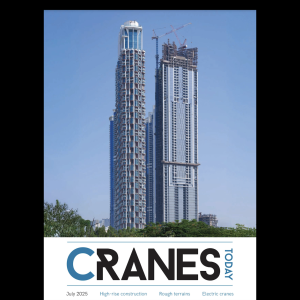
In the balance
Obtaining a permit to move a large all-terrain crane legally on public roads involves knowing its weight, and the standard way of weighing a crane is by driving it over a mobile scale one axle at a time. But rubber-tyred cranes that have hydro-pneumatic drive and suspension systems cannot be weighed that way: the axle suspension compensates for unevenness in the ground – such at the weighing pan – by continually varying the load on each axle. Thus simply adding up the axle loads that are imparted to the weighing machine will not give the true weight of the crane. Weigh the same crane twice on the same set of scales and you can get two wildly different readings.
It is a problem that so far seems to have no clear solution. SC&RA are preparing a white paper and a video on the issue.
Weight loss problems
A second legal issue in North America, again concerning weight and road travel, is that of non-divisible loads. Regulations require that specialised vehicles that exceed the normal road weight limits should reduce their excess weight to a minimum by having removable parts of their load taken off and sent on separate trucks, leaving just the ‘non-divisible’ portion of the load on the main carrier. What exactly constitutes ‘non-divisible’ has been unclear, and has been differently interpreted by different states. Are counter-weights, booms, and fly-jibs included? What of fuel in the tank? These can all be removed from a crane, with greater or lesser ease.
One definition used by transport authorities has been the so-called ‘eight-hour rule.’ If a component can be detached in under eight hours of labour it has been counted as ‘divisible.’ Detaching such components the yard and then re-attaching them at the job site of course greatly increases labour costs and set-up times.
However, following representations by SC&RA, federal authorities have at least partially clarified the position. State authorities have been informed that the eight-hour rule is not to be considered definitive. “Word has come down that they should not hang their hats on the eight-hour rule” says Steve Todd, vice president of SC&RA.
Instead, the key consideration becomes whether or not a component is necessary for the specialised vehicle to perform its designed function. Fly-jibs, booms and the like clearly fall into this category. On mobile cranes, additional objects can therefore be carried if the job cannot be done without them. They must, of course, be safely secured.
Spreader bar not load
Another decision of legal importance has arisen from the recently-concluded case of MSHA vs Sims Crane. At a mine site in Florida a crane operator and his helper walked under an unloaded spreader bar. A citation was issued. The case partly turned on whether a spreader bar counts as part of the ‘suspended load’ of a crane. The case went to appeal. Although Sims Crane lost the appeal, it was determined that the spreader bar is not part of the suspended load of a crane.
Break time
The SC&RA is proposing to attempt to overturn California’s law on mandatory meal and rest break requirements for drivers. California Wage Order 9 requires trucking companies to provide transportation drivers with a 30-minute meal break every 5 hours and a ten-minute rest break every four hours. The order affects any transportation, whether interstate or intrastate, and carries a penalty of $150, rising to $200 for subsequent violations. Washington, Oregon, and New York state have similar policies, and other states may attempt to follow.






